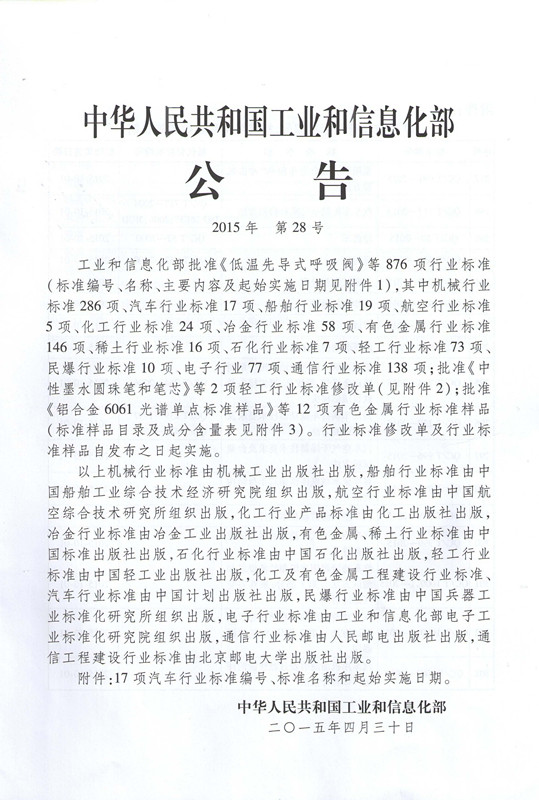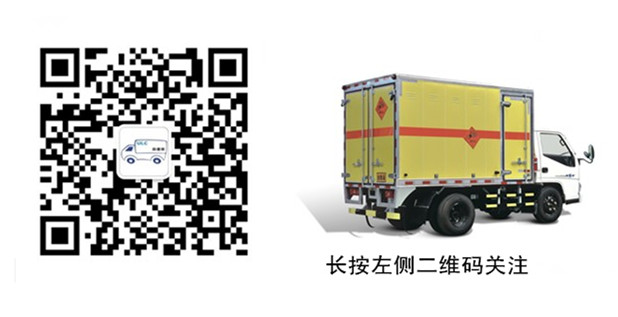
Automotive Industry Standards of the People's Republic of China
QC/T993-2015
Explosive transport vehicle
Released on May 30th, 2015 Implemented on October 1st, 2015
Issued by the Ministry of Industry and Information Technology of the People's Republic of China
catalogue
Preface
1 Scope
2 Normative References
3 Terms and definitions
4 Requirements
5 Test methods
6 Inspection Rules
7 Signs, Identification, and User Manual
8 Accompanying documents, transportation, and storage
Appendix A (normative appendix) Technical requirements and inspection rules for explosion-proof containers
Appendix B (informative appendix) List of names of civilian explosives
Fireworks and firecrackers transport vehicle
Preface
This standard is drafted in accordance with the rules given in GB/T 1.1-2009.
Please note that certain contents of this standard may involve patents, and the issuing authority of the standard does not assume the responsibility of identifying these patents.
This standard is proposed by the Ministry of Industry and Information Technology of the People's Republic of China.
This standard is under the jurisdiction of the National Automotive Standardization Technical Committee.
Drafting units of this standard: Zhengzhou Hongyu Special Purpose Vehicle Co., Ltd., Weapon Industry Safety Technology Research Institute, China Weapon Industry Second and Third Research Institute, Shanghai Aviation Special Vehicle Co., Ltd., Jinhua Jiangyouming Carriage Manufacturing Co., Ltd., Zhongtian High tech Special Vehicle Co., Ltd., Shandong Zhengtai Hill Special Purpose Vehicle Co., Ltd., Jiangxi Jiangling Automobile Group Modified Vehicle Co., Ltd Hunan Jinhua Vehicle Co., Ltd., Hunan Futeng He Security and Explosion Prevention Technology Co., Ltd., and Hanyang Special Vehicle Research Institute
The main drafters of this standard are Wang Jianguo, Bai Chunguang, Hou Yonghua, Zhe Enyi, Tu Zhongming, Jiang Youming, Duan Liancheng, Dong Jinhui, Ling Liangxing, Dai Yong, Tang Heping, Yao Hongzhi, Xia Jie, Li Genyun, He Xiaosan, and Wang Dongtang
This standard is issued for the first time.
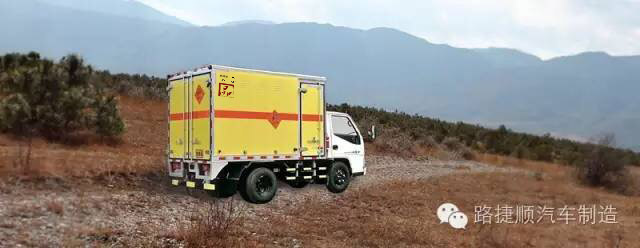
1 Scope
This standard specifies the terms and definitions, requirements, test methods, inspection rules, markings, markings, user manuals, accompanying documents, transportation, storage, and other contents of explosive transport vehicles.
This standard is applicable to explosive transport vehicles (hereinafter referred to as "vehicles") that are modified using a standardized vehicle or a standardized Class II chassis.
2 Normative References
The following documents are essential for the application of this document. For dated references, only the dated version applies to this document. For undated references, the latest version (including all modification orders) applies to this document.
GB 1589 Dimensions, Axle Load, and Mass Limits for Road Vehicle Outlets
GB 4715 point type smoke fire detector
GB 4785 Installation Regulations for External Lighting and Light Signaling Devices of Motor Vehicles and Trailers
GB 6944-2012 Classification and Product Name Numbers of Dangerous Goods
GB 7258 Technical Conditions for Motor Vehicle Operation Safety
GB 8031 Industrial Electric Detonator
GB/T 8162 Seamless Steel Tubes for Structural Purposes
GB/T 9969 General Principles of Industrial Product User Manual
GB 11567.1 Side Protection Requirements for Motor Vehicles and Trailers
GB 11567.2 Requirements for Rear Underbody Protection of Vehicles and Trailers
GB/T12673 Measurement methods for main dimensions of automobiles
GB/T 12674 Automotive Mass (Weight) Parameter Measurement Method
GB 13365 Motor Vehicle Exhaust Spark Extinguishers
GB 13392 Road Transport Dangerous Goods Vehicle Markings
GB/T 13594 Anti lock Braking Performance and Test Methods for Motor Vehicles and Trailers
GB/T 17350 Terminology and Codes for Special Purpose Vehicles and Special Purpose Semi trailers
GB/T 18411 Road Vehicle Product Labels
GB/T 19056 Automotive Travel Recorder
GB20300 Safety Technical Conditions for Road Transport of Explosives and Highly Toxic Chemicals Vehicles
GB 21668 Structural Requirements for Dangerous Goods Transport Vehicles
GB/T 24545 Technical Requirements for Vehicle Speed Limit Systems
GB 25990 Vehicle Rear Sign Plate
GB 50089 Safety Code for Design of Civil Blasting Equipment Engineering
QC/T 252 Type Approval Test Procedure for Special Purpose Vehicles
QC/T 484 Automotive Paint Coatings
QC/T 639 Rubber Sealing Strip for Automobile
JB/T 5943 General technical specifications for welding components of construction machinery
JT 230 Automotive Static Conductive Rubber Trailer
JT 230 Automotive Static Conductive Rubber Trailer
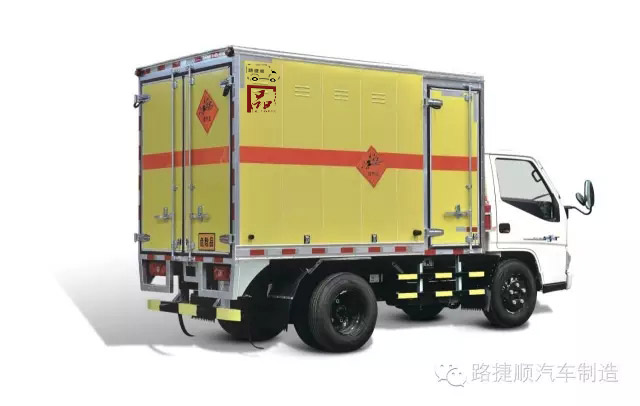
3 Terms and definitions
The terms and definitions established in GB/T17350 and the following apply to this document.
3.1
Explosive transport vehicle
Vehicles transporting explosives. Including civilian explosives transport vehicles, fireworks and firecracker transport vehicles, and explosives co carrier vehicles.
3.2
Fireworks
Made from pyrotechnic powder as the main raw material, it ignites and produces effects such as light, sound, color, shape, and smoke through combustion or explosion. It is used for viewing and for items with flammable and explosive hazards.
3.3
Fireworks transport vehicle
A vehicle specialized in transporting fireworks and firecrackers, which has anti-theft, fire prevention, anti-static, collision prevention, spark prevention, insulation and insulation functions, as well as explosion-proof and explosion relief functions.
4 Requirements
4.3 Fireworks and firecrackers transport vehicle
4.3.1 Fireworks and firecrackers transport vehicles should be equipped with temperature sensors and water level sensors.
4.3.2 An audible and visual alarm should be installed in the cab of the fireworks and firecracker transport vehicle. When the environmental status parameters reach one of the environmental conditions (warning threshold), the alarm should be activated in a hierarchical manner. Grading startup should comply with the requirements of Table 2:

4.3.3 Fireworks and firecrackers transport vehicles should be equipped with a device to prevent the chassis hub from overheating due to braking. When the hub overheating reaches the warning threshold temperature, it should be able to alarm.
4.3.4 The top of the carriage of the fireworks and firecrackers transport vehicle should have a waterfall discharge function. If an explosion relief device is installed on the top of the carriage, the ratio of the area between the explosion relief port and the top of the carriage should not be less than 55%, and the explosion relief port should be able to be opened automatically or manually.
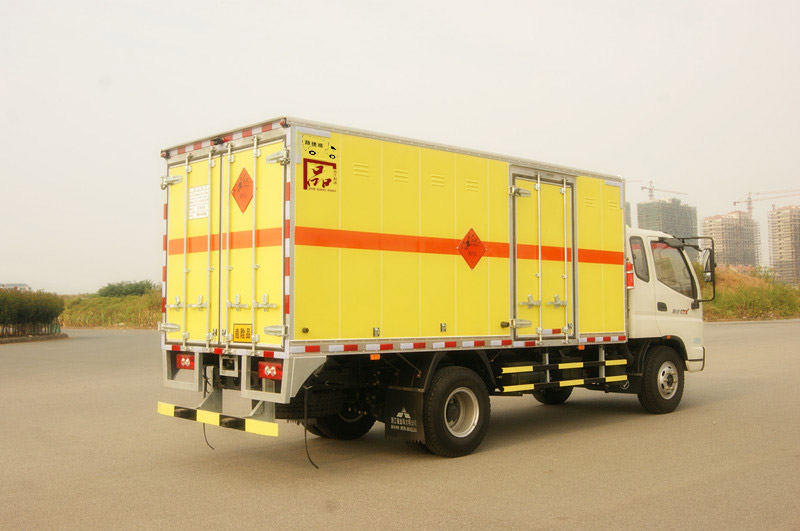
5 Test methods
5.1.1 The measurement of vehicle external dimensions shall be carried out in accordance with the provisions of GB/T12673, and the measurement of axle load and mass shall be carried out in accordance with the provisions of GB/T12674.
5.1.2 The driving safety related tests of vehicles shall be carried out in accordance with the relevant provisions of GB7258.
5.1.3 The inspection of the external lighting and light signaling devices of the vehicle shall be carried out in accordance with the provisions of GB4785.
5.1.4 The testing of vehicle side and rear lower protection devices shall be carried out in accordance with the provisions of GB 11567.1 and GB 11567.2. Measure the buffer size of the front and rear protective devices.
5.1.5 Visually inspect the installation position of the exhaust pipe and measure the relative position between the exhaust pipe and the fuel tank with a ruler. When the exhaust pipe is installed below the cargo compartment floor, the reliability and effectiveness of installing an insulation board between the exhaust pipe and the cargo compartment floor should be checked.
5.1.6 Check the installation position and quantity of static conductive rubber towing strips.
5.1.7 Check the installation positions of hazard alarm systems, smoke and fire detectors, alarm buzzers, anti-theft alarm systems, and rear video monitoring systems for vehicles transporting civilian explosives, and test their functional effectiveness.
5.1.8 Check the specifications of the tires and the number of dry powder fire extinguishers.
5.1.9 Rainproof sealing test
The carriage door is closed normally. When the rainfall intensity is ≥ 0.12mm/s, a rain gauge should be used to measure the rainfall. The artificial rainfall on the rain test bench should cover the entire carriage. After a 15 minute rain proof sealing performance test, dry the external water accumulation of the carriage, open the car door, and check for water ingress and leakage in all parts of the carriage.
5.1.10 Visually inspect the structure of the cargo compartment, ventilation windows on the side walls of the cargo compartment, rubber products equipped to alleviate cargo collisions, flame retardant and static conductive rubber plates laid, and measure their thickness and dimensions, as well as safety components such as door rubber seals.
5.1.11 Static conductivity test
The interior of the cargo compartment should be clean, and a megohmmeter should be used to measure the resistance between the floor of the cargo compartment and the connection of the towing strip. Measure one point every 2m2 and calculate the average value.
5.1.12 Alarm performance test
Open the rear or side door, check if the alarm device in the driver's cab sounds within 10 seconds, and measure the sound level of the alarm using a noise meter.
5.1.13 Visually inspect the installation positions of temperature sensors, pressure sensors, water level sensors, and audible and visual alarms on the fireworks and firecracker transport vehicle; A device for spraying water on wheels and tires; Check the position of the explosion vent, measure and calculate the ratio of the area of the explosion vent to the top of the carriage; Check the automatic or manual opening method of the explosion vent.
5.1.14 Visually inspect the installation positions of temperature sensors, pressure sensors, water level sensors, and audible and visual alarms on the fireworks and firecracker transport vehicle; A device for spraying water on wheels and tires; Check the position of the explosion vent, measure and calculate the ratio of the area of the explosion vent to the top of the carriage; Check the automatic or manual opening method of the explosion vent.
6 Inspection Rules
6.1.1 Appearance;
b) Vehicle size and mass parameters;
c) Signs and markings;
d) Installation of external lighting and light signaling devices;
e) Installation dimensions of protective devices;
f) Exhaust pipe installation;
g) Functional inspection of hazard alarm system;
h) Rainproof sealing;
i) Anti theft alarm performance.
6.2 Type inspection
6.2.1 Type inspection should be carried out in one of the following situations:
a) When a new or old product is transferred to another factory for trial production and finalization;
b) Accumulated normal production output of 2000 vehicles;
c) When production resumes after 3 years of product discontinuation;
d) After formal production, if there are significant changes in materials and processes that may affect product performance;
e) When there is a significant difference between the factory inspection and the type inspection.
During the type inspection in 6.2.2, if it falls under the two situations of a) and b) in 6.2.1, the inspection should be carried out in accordance with Chapter 4, QC/T252, and relevant national regulations; If it falls under the condition of c) in 6.2.1, the dedicated performance should be inspected; If it falls under the two situations of d) and e) in 6.2.1, only the affected items can be inspected.
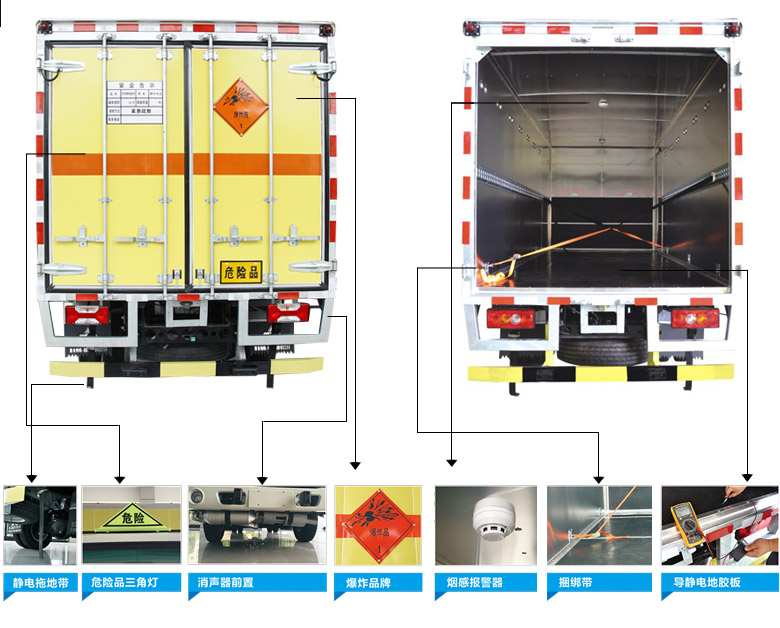
7 Signs, Identification, and User Manual
7.1 Marks and Identification
7.1.1 There should be safety sign graphics and text on the vehicle. Safety signs, signs, and lights should comply with the relevant provisions of GB13392, GB20300, and GB7258.
7.1.2 Product labels should be installed on the vehicle, and the content of the labels should comply with the provisions of GB/T18411 and GB7258.
7.1.3 The side and rear of the vehicle compartment should be equipped with reflective markings and orange reflective tape that can reflect the outline of the cargo compartment, and their requirements should comply with the provisions of GB20300 and GB7258. Vehicles with a total mass greater than or equal to 12000 kg should also be equipped with rear end marker plates that comply with GB25990 regulations.
7.1.4 The inner side of the vehicle's cargo compartment door should be pasted with the "Transportation Table for Civilian Explosives in the Same Vehicle" that meets the storage requirements of hazardous materials in the same warehouse as specified in the GB50089 standard.
7.2 User Manual
The preparation of the vehicle user manual should comply with the provisions of GB/T9969 and GB7258, and should include the following content:
a) Product name and model;
b) Name and detailed address of the production enterprise;
c) Technical characteristics;
d) Structural characteristics;
e) Use and maintenance;
f) Technical maintenance;
g) Emergency response methods;
h) Table for the transportation of civilian explosives on the same vehicle.
8 Accompanying documents, transportation, and storage
8.1 Accompanying documents
The accompanying documents should include:
a) Product qualification certificate and chassis qualification certificate;
b) Product user manual;
c) Car (chassis) user manual;
d) List of accompanying spare parts and accessories.
8.2 Transportation
When vehicles are transported by railway (or waterway), they can get on and off (ships) by self driving (or towing). If lifting is necessary for loading and unloading, special lifting tools must be used to prevent damage to the product.
8.3 Storage
When the vehicle is parked for a long time, the coolant and fuel should be drained, the power should be cut off, the doors and windows should be locked, and placed in a ventilated, moisture-proof, and fire-fighting area. Regular maintenance should be carried out according to the product manual.
